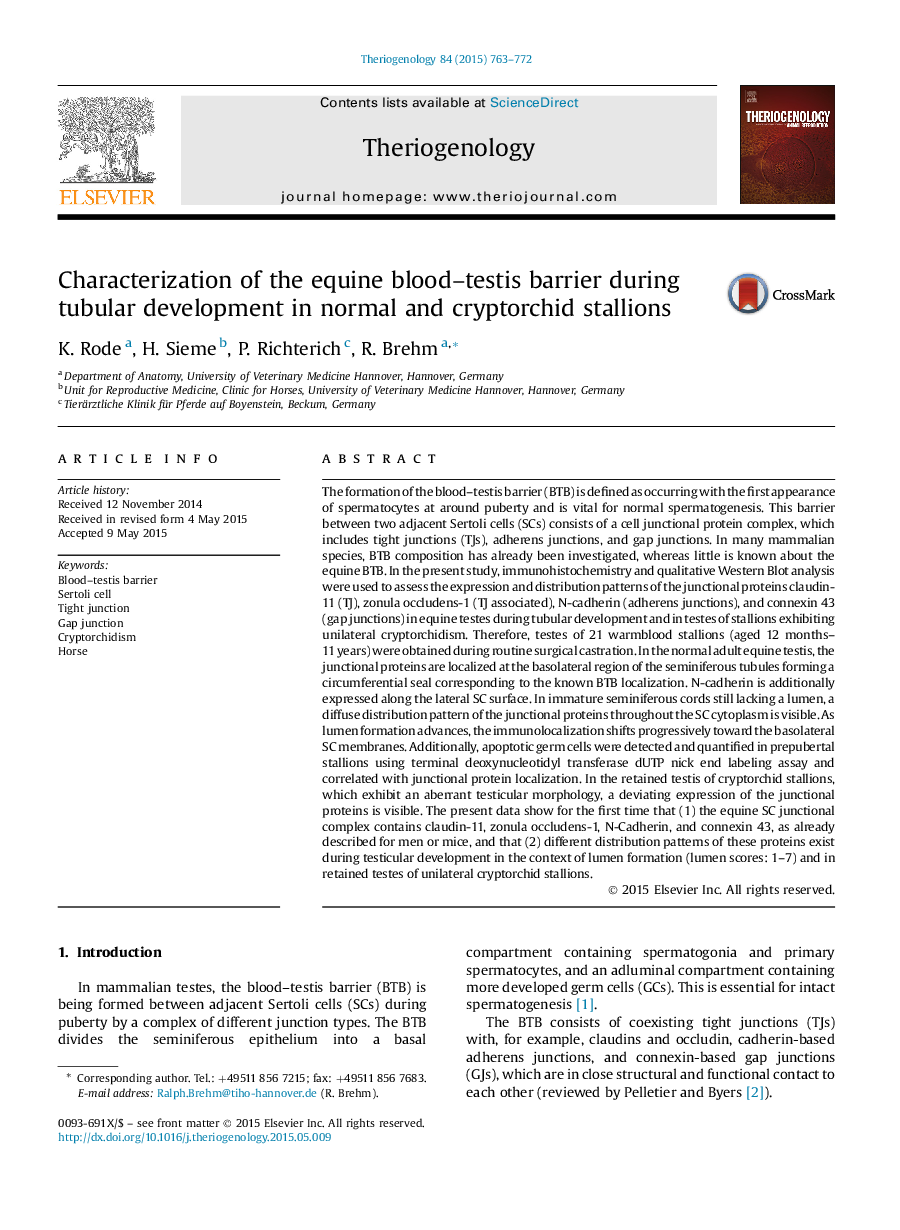| کد مقاله | کد نشریه | سال انتشار | مقاله انگلیسی | نسخه تمام متن |
|---|---|---|---|---|
| 10891779 | 1082065 | 2015 | 10 صفحه PDF | دانلود رایگان |
عنوان انگلیسی مقاله ISI
Characterization of the equine blood-testis barrier during tubular development in normal and cryptorchid stallions
ترجمه فارسی عنوان
مشخص کردن مانع خون ادراری اسب در طول رشد لوله در نرهای معمولی و کریپتورچید
دانلود مقاله + سفارش ترجمه
دانلود مقاله ISI انگلیسی
رایگان برای ایرانیان
کلمات کلیدی
موضوعات مرتبط
علوم زیستی و بیوفناوری
علوم کشاورزی و بیولوژیک
علوم دامی و جانورشناسی
چکیده انگلیسی
The formation of the blood-testis barrier (BTB) is defined as occurring with the first appearance of spermatocytes at around puberty and is vital for normal spermatogenesis. This barrier between two adjacent Sertoli cells (SCs) consists of a cell junctional protein complex, which includes tight junctions (TJs), adherens junctions, and gap junctions. In many mammalian species, BTB composition has already been investigated, whereas little is known about the equine BTB. In the present study, immunohistochemistry and qualitative Western Blot analysis were used to assess the expression and distribution patterns of the junctional proteins claudin-11 (TJ), zonula occludens-1 (TJ associated), N-cadherin (adherens junctions), and connexin 43 (gap junctions) in equine testes during tubular development and in testes of stallions exhibiting unilateral cryptorchidism. Therefore, testes of 21 warmblood stallions (aged 12 months-11 years) were obtained during routine surgical castration. In the normal adult equine testis, the junctional proteins are localized at the basolateral region of the seminiferous tubules forming a circumferential seal corresponding to the known BTB localization. N-cadherin is additionally expressed along the lateral SC surface. In immature seminiferous cords still lacking a lumen, a diffuse distribution pattern of the junctional proteins throughout the SC cytoplasm is visible. As lumen formation advances, the immunolocalization shifts progressively toward the basolateral SC membranes. Additionally, apoptotic germ cells were detected and quantified in prepubertal stallions using terminal deoxynucleotidyl transferase dUTP nick end labeling assay and correlated with junctional protein localization. In the retained testis of cryptorchid stallions, which exhibit an aberrant testicular morphology, a deviating expression of the junctional proteins is visible. The present data show for the first time that (1) the equine SC junctional complex contains claudin-11, zonula occludens-1, N-Cadherin, and connexin 43, as already described for men or mice, and that (2) different distribution patterns of these proteins exist during testicular development in the context of lumen formation (lumen scores: 1-7) and in retained testes of unilateral cryptorchid stallions.
ناشر
Database: Elsevier - ScienceDirect (ساینس دایرکت)
Journal: Theriogenology - Volume 84, Issue 5, 15 September 2015, Pages 763-772
Journal: Theriogenology - Volume 84, Issue 5, 15 September 2015, Pages 763-772
نویسندگان
K. Rode, H. Sieme, P. Richterich, R. Brehm,
